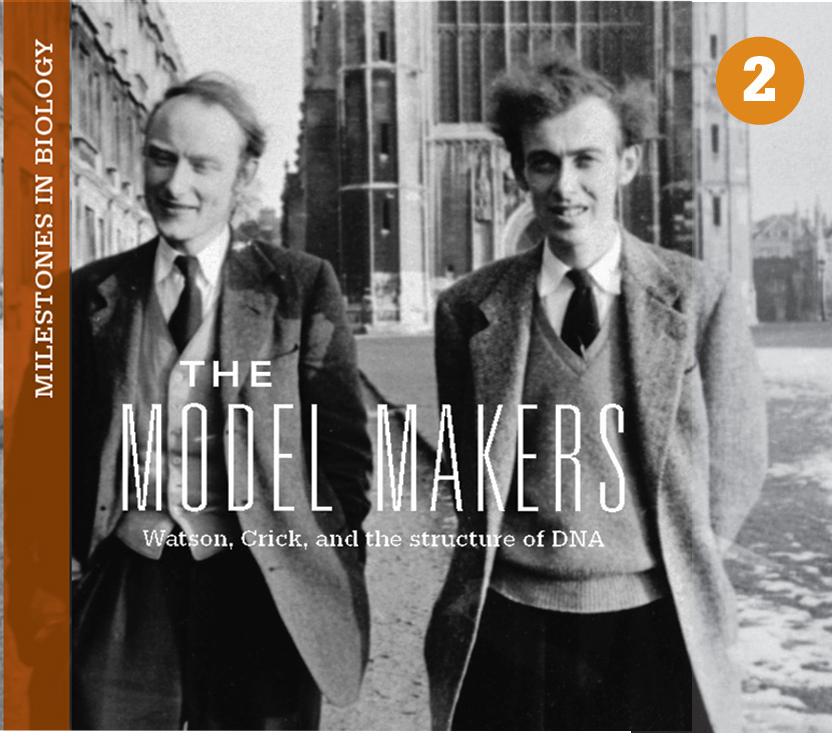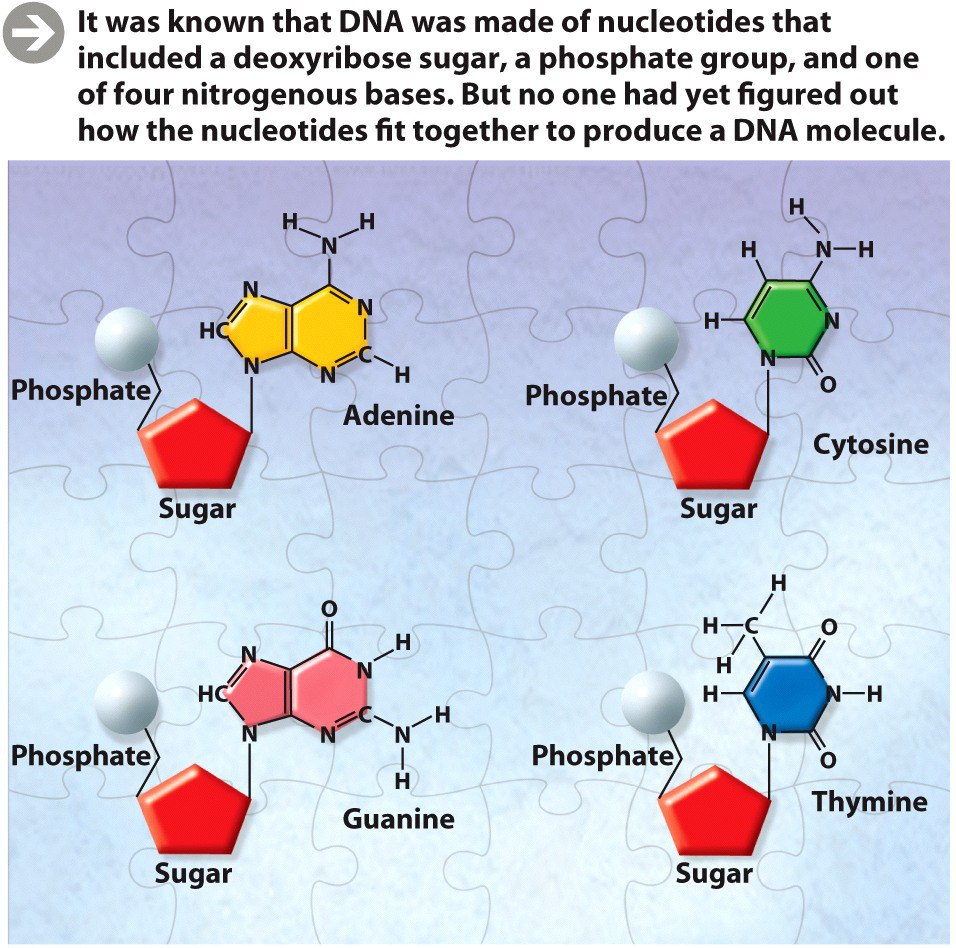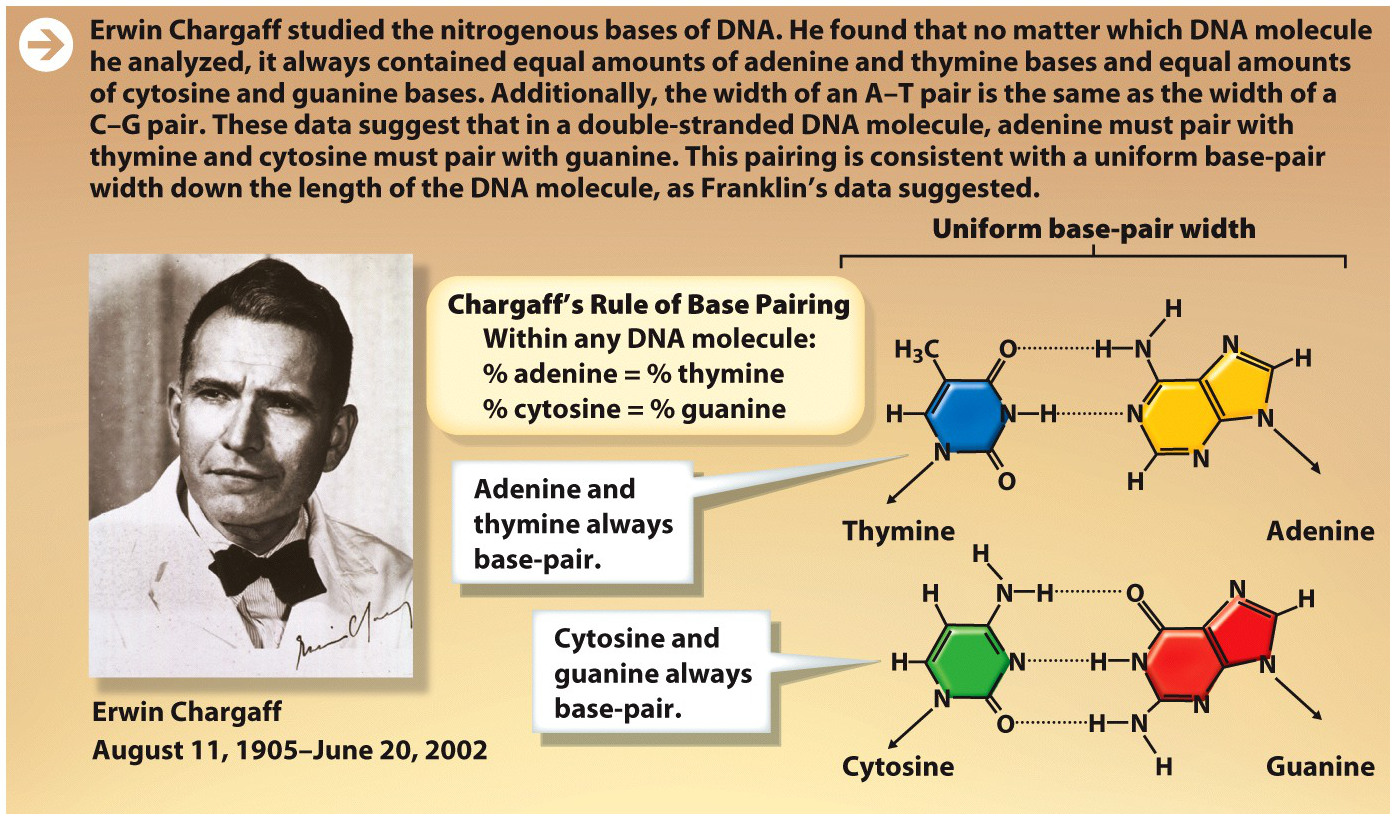154

155
DRIVING QUESTIONS
- Who were the major players in the discovery of the structure of DNA?
- What pieces of scientific knowledge were assembled in order to elucidate the structure of DNA?
 N 1953, WITH INFLATED EGOS, JAMES WATSON AND FRANCIS Crick announced to a crowd in their favorite pub in Cambridge, England, that they had found the secret of life. Given the nature of their discovery, they had every right to boast: in revealing the structure of DNA, they had solved one of the greatest mysteries of science–the chemical basis of inheritance. Their discovery would revolutionize biology and push forward the study of anthropology, evolution, and medicine.
N 1953, WITH INFLATED EGOS, JAMES WATSON AND FRANCIS Crick announced to a crowd in their favorite pub in Cambridge, England, that they had found the secret of life. Given the nature of their discovery, they had every right to boast: in revealing the structure of DNA, they had solved one of the greatest mysteries of science–the chemical basis of inheritance. Their discovery would revolutionize biology and push forward the study of anthropology, evolution, and medicine.
But Watson and Crick’s success wasn’t merely the result of a marriage between two great minds. Scientific breakthroughs rarely result from single scientists working in a vacuum. Rather, breakthroughs happen when scientists are well positioned to build upon foundations laid down by other scientists. And so it was with DNA. In addition to their own insight, Watson and Crick built on the discoveries of others. They also had luck on their side–they were in the right place at the right time.
Watson and Crick had met in 1951 at Cambridge University, in England. Watson was an American scientist who had just accepted a research position at the university. Crick was then a Ph.D. student, studying protein structure with a technique called x-ray crystallography.
Given their varied backgrounds, the men didn’t appear obvious collaborators. Watson was a prodigy. Twelve years younger than Crick, he had earned his Ph.D. at 22. Crick, by contrast, was a late bloomer. He was 38 years old by the time he had his Ph.D. But what they did share was intellectual curiosity. Both had changed their research focus several times. By their own admission, both were more interested in solving current hot topics in science–like the structure of DNA–than pursuing the more obscure science that each had trained to do.
156
Although DNA was first observed in cell nuclei in the late 1860s, it took almost a century before scientists realized its importance. For a long time, the prevailing belief was that proteins carried the genetic information. But by the 1950s it was known that DNA, not protein, was the genetic material. Scientists still, however, didn’t understand the structure of DNA, or how it carried genetic information. Solving this problem became a quest for many scientists of the day.
When Crick and Watson came to the problem, they already knew, from the work of other scientists, that DNA was made up of nucleotides containing a sugar, a phosphate group, and one of four bases: adenine, thymine, cytosine, or guanine. But how did the elements fit together? To answer this question, they took inspiration from the chemist Linus Pauling. Pauling had been studying the structure of proteins and had built a molecular model showing that some proteins exist as a single-stranded, twisting helix. He backed up his model with lab experiments to prove his structure was correct. If an eminent scientist like Pauling could model a structure without first conducting laboratory experiments, Watson and Crick thought they might be able to do the same with DNA (INFOGRAPHIC M2.1).

Using wire and metal, Watson and Crick began building scale models of DNA on the basis of existing evidence about the chemical structure of nucleotides. They initially built a three-helix model with the phosphate groups on the inside and the bases radiating outward. But experts who analyzed the structure deemed it chemically unstable.
Then came a crucial finding. In 1951, Watson attended a lecture by a young scientist named Rosalind Franklin. In her laboratory at King’s College London, she had been making x-ray diffraction pictures of DNA. X-ray diffraction analyzes the way x-rays bounce off a sample of material in order to determine the chemical structure of that material. Franklin had observed that increasing the humidity of a DNA sample caused it to elongate. To Franklin, this suggested that water molecules were being attracted to the helix, coating it and causing it to stretch out. And, since water is a polar molecule (see Chapter 2), attracted to charged (hydrophilic) molecules, this further suggested that the charged, water-loving phosphate groups of DNA must therefore be on the outside of the helix–not, as others had suggested, on the inside.
Franklin’s contribution didn’t end there. She also discovered other important facts about the structure of DNA. Working with a graduate student, Raymond Gosling, she found that her x-ray diffractions confirmed that the elongated form of DNA had all the characteristics of a twisting helix (INFOGRAPHIC M2.2).
157

Maurice Wilkins, who was Franklin’s peer and worked in the same laboratory, was also studying DNA structure at the time. In 1953, Wilkins saw Franklin’s best unpublished x-ray picture of DNA and showed it to Watson without Franklin’s knowledge. “The instant I saw the picture my mouth fell open,” Watson recalled in his memoir of the discovery, The Double Helix, published in 1968. The sneak preview “gave several of the vital helical parameters.”
158
With that clue in hand, Watson and Crick then took a crucial conceptual step and suggested that the molecule was made of two chains of nucleotides. Each formed a helix, as Franklin had found, but because the DNA molecule was symmetrical–it looked the same when flipped upside down and backward–they realized that the two chains of nucleotides must be oriented in opposite directions.
To construct the model, Watson and Crick also built on a discovery made a few months earlier. In 1952, Erwin Chargaff had found that DNA contained equal amounts of adenine and thymine and equal amounts of guanine and cytosine. This information was critical. As the helix had a smooth shape and a uniform thickness, and as the bases had to point toward the inside of the helix, the different-size bases somehow had to fit together in way that allowed for a consistent length of base pairs. Following a tip about the structure of bases, Watson and Crick were able to use a model to show that A–T pairs and G–C pairs were exactly the same length, explaining the consistent helix shape, and also accounting for Chargaff’s finding that the amounts of A and T were equal, as were the amounts of G and C (INFOGRAPHIC M2.3).

The final double-helix model so perfectly fit the experimental data that the scientific community almost immediately accepted it. Watson and Crick published their paper on the structure of DNA in April 1953 in the prominent journal Nature. In it, with considerable understatement, they wrote: “It has not escaped our notice that the specific pairing we have postulated immediately suggests a possible copying mechanism for the genetic material.” Indeed, the model that Watson and Crick proposed solved at once both the structure of DNA and how this structure provides a mechanism for DNA replication (see Chapter 7). The mystery of inheritance had finally been unlocked.
159
The final double-helix model so perfectly fit the experimental data that the scientific community almost immediately accepted it.
Alongside their paper, in the same issue, individual papers by Wilkins and Franklin discussed their respective x-ray diffraction results. In 1962, Watson, Crick, and Wilkins shared the Nobel Prize in Physiology or Medicine (INFOGRAPHIC M2.4).

160
But what about Franklin? Franklin had died of ovarian cancer in 1958, at the age of 37. By Nobel Foundation rules, she was ineligible for nomination since prizes are not awarded posthumously.
Controversy over whether Franklin has been adequately recognized continues. Although Watson and Crick acknowledged her contribution to their research in their article in Nature, the extent to which her input helped them build their DNA model was revealed only much later in Watson’s 1968 book, published 10 years after Franklin’s death. For example, at the time Nature published the papers on DNA structure, Franklin’s paper was perceived as merely supporting evidence. But it was her data that helped Watson and Crick clinch the structure. Some historians argue that sexist attitudes prevented her from receiving the acclaim she deserved before she died. At the time, female scientists in the biomedical sciences were few and were frequently confronted by negative attitudes from their male peers. “I’m afraid we always used to adopt–let’s say, a patronizing attitude towards her,” Crick publicly commented after Watson’s book was published. He added that if Franklin had lived, “It would have been impossible to give the prize to Maurice [Wilkins] and not to her” because “she did the key experimental work.”
Although it was quite normal for colleagues to share data, some have even argued that Wilkins showed Franklin’s critical x-ray diffraction photos to Watson out of jealousy or disdain.
Despite controversy, Franklin’s contribution to the discovery has never been completely ignored, and she is now recognized as having been a top-notch scientist: her notebooks show that without her thorough scientific research and original ideas, we would have had to wait much longer for what is still considered to be one of the most important discoveries in biology.
It would have been impossible to give the prize to Maurice [Wilkins] and not to [Franklin because] she did the key experimental work.
—FRANCIS CRICK
MORE TO EXPLORE
 Watson, J. D., and Crick, F. H. C. (1953) A structure for deoxyribose nucleic acid. Nature 171:737–738.
Watson, J. D., and Crick, F. H. C. (1953) A structure for deoxyribose nucleic acid. Nature 171:737–738.
 Watson, J. D. (2001 [1968]) The Double Helix: A Personal Account of the Discovery of the Structure of DNA. New York: Touchstone Books.
Watson, J. D. (2001 [1968]) The Double Helix: A Personal Account of the Discovery of the Structure of DNA. New York: Touchstone Books.
 Maddox, B. (2003) Rosalind Franklin: The Dark Lady of DNA. New York: Harper Perennial.
Maddox, B. (2003) Rosalind Franklin: The Dark Lady of DNA. New York: Harper Perennial.
161